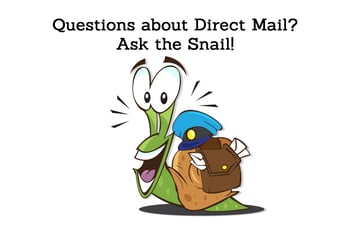
You've heard us say it before and we're saying it again in 2021...direct mail still isn't dead, and we're here to tell you why. Check out the stats and facts on how we know direct mail is alive and well.
We’ve all heard it many, many times — direct mail is dead. But is that really true? Yes, digital marketing has taken hold, and it isn’t going anywhere. However, that does not make direct mail any less valuable. In fact, direct mail may be more valuable than ever because marketers have realized that every marketing effort works to support the others, and each accomplishes something unique that the others cannot. And, living in the times of COVID with so many people hunkering down at home, direct mail is a welcomed distraction expected to climb back to pre-pandemic volumes in the first half of 2021. [1]
In spite of what the skeptics have said, the future for direct mail is promising. And even with 2020’s decrease in direct mail volume (-14.7%), this $8B industry earns its place at the top of the Harris Poll COVID-19 Essential 100 list. But, in order to get the maximum value out of your mailing plan, it’s important to understand where direct mail circulation stands today and why direct mail is an integral piece of so many marketing plans.
The State of Direct Mail
Direct mail hasn’t just been limping along, merely surviving the digital revolution. The truth is, direct mail is thriving. As more companies embrace online forms of communication, the average home receives fewer communications via traditional mail, which means your direct mail pieces have a better chance of standing out among the reduced clutter if you provide the customer with value, addressing their needs, desires and pain points.
Consider these facts:
- 70-80% of mail recipients review all of their mail — even mail they don’t necessarily care about.
- ~80% of direct mail recipients take immediate action on the mail they receive vs. 45% of email recipients.
- 95% of 18 - 29 year olds react positively to direct mail.
- Direct mail yields a 70% higher recall rate than other advertising.
- The average direct mail campaign sent to existing customers yields a 5.1% response rate (RR) and a 2.9% RR for new customer acquisition [2]. Similar email campaigns have a response rate of <.5%.
The numbers don’t lie. Direct mail is alive and well and can be used effectively to reach new prospects and existing customers. Direct mail is both subtly intrusive and tactile, two very powerful attributes for an advertising medium.
Learn why E-commerce marketers must rethink the consumer experience and their role in delivering effective marketing at every touchpoint.
How Direct Mail Has Influenced Marketing
What’s even more impressive than direct mail’s continued effectiveness is its influence on newer forms of marketing. The core principles of direct mail and direct mail circulation can be found in many aspects of digital marketing, further cementing direct mail’s status as a driving force in modern-day businesses.
Inbound marketing is centered around building a list of interested parties and tailoring the marketing message around the activity of those individuals. That’s a concept that comes directly from direct mail. Inbound marketing has also borrowed the personalization that’s commonplace in direct mail, creating a digital complement to the tried-and-true methods that have worked for decades.
Content marketing is another discipline that has its roots in direct mail. Sending supplementary content with industry information has been a staple of direct mail for some time. We’re just now beginning to see the digital equivalent of this approach in how companies are tailoring all their content — from articles to tweets to website copy to emails — to meet the audience’s needs by providing value through knowledge, services, offers and more. As consumers continue to make their voices heard and demand a meaningful experience across all channels, companies will be able to use the insights direct mail has gathered on audience segments to actively focus on the consumer and improve every interaction, whether online or offline.
Another area where direct mail has influenced digital marketing is through the circulation of catalogs. Recognizing that catalogs are more fun and easier to browse than an endless list of merchandise-laden webpages, companies have begun distributing their catalogs via their websites, but it’s important not to underestimate the value of a well-distributed physical catalog.
While Retargeting has its roots in digital advertising, it’s evolution to direct mail is worth noting. Direct mail is an out-of-the-box approach to remarketing that has the potential to have a sizable impact on consumer engagement and site conversions – Yes, even in e-commerce. [3] It’s no surprise that we’ve seen many ecommerce players expand into direct mail; Bonobos, Amazon, Warby Parker.
The Bigger Picture
It’s not all about direct mail being the shining star of your company. It’s not even about catalog recipients spending more than people who don’t receive your catalogs. According to IWCO Direct, cross-channel marketing can increase your response rates by 35%. The important thing is that people buy something, somehow, from your company.
Every action taken in marketing works to support the others to create a meaningful customer experience, at every touchpoint, from beginning to end. And knowing what the customer expects at any given point in their path-to-purchase will help you determine how and where you should direct your advertising focus — if by paid search, social media marketing, email or with a catalog. This consumer-focused approach is redefining how companies approach marketing, which allows every marketing effort to showcase and build on its particular strengths.
As part of an effective overall marketing campaign, direct mail remains highly relevant, and it will continue to be for the foreseeable future. Even in a largely digital world, there’s a purpose for direct mail and physical catalogs that cannot be replaced or removed without losing a valuable and effective means of reaching prospects and existing customers.
[1] https://www.sequeldm.com/the-state-of-direct-mail-during-covid-19-and-beyond
[2] https://sumo.com/stories/direct-mail-marketing-examples
[3] https://www.enthusem.com/blog/5-surprising-benefits-of-direct-mail-marketing-in-e-commerce

Lookalike Audiences Enhance customer acquisition by identifying high-potential prospects, boosting response rates, and lowering advertising costs.
Retargeting Postcards Double the performance of your direct mail retargeting.
Amplify Recognize unknown visitors who are actually customers. Add 20-40% to your ESP/CRM campaigns.
IQ Mail Retain customers with personalized, timely messages for those opting out of digital channels.


.png?width=450&height=250&name=Blog%20Images%20(1).png)


Comments